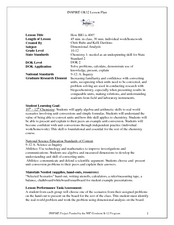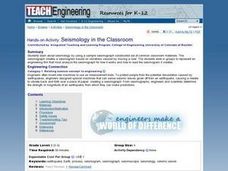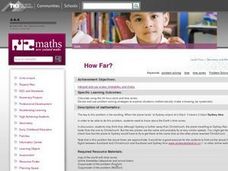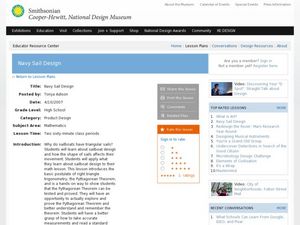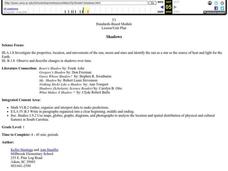Curated OER
How BIG is 400?
Students solve problems using dimensional analysis. In this chemistry lesson, students choose a problem and present it in class. The rest of the class will evaluate the solved problem on the board.
Curated OER
Energy Audit
Students examine the level of energy usage on a local and national level. Using the internet, they discover ways to conserve energy every day and how over-consumption of energy negatively affects the environment. In groups, they...
Curated OER
International Human Rights Day
Young scholars read the plain language version of the Universal Declaration of Human Rights and consider its relevance today. They discuss the following questions: How does the Universal Declaration of Human Rights apply to your own...
Curated OER
A Trillion Here...A Trillion There
In this working with large numbers learning exercise, students are given the finance statistics for the US and the world for the 2006-2007 year. Students solve 11 problems including finding averages and percentages for the given...
Curated OER
Biospheres in Your Backyard
Students collect data from a local river biome. They use the information for metric conversion and graphing equations. They study the components of what makes up a biosphere and how math is used to analyze one.
Curated OER
Lake Superior Ecology Unit
Sixth graders research Lake Superior and its ecosystem. Students investigate the lake's cycles of mixing and stratification and how these cycles affect the biology of the lake. This lesson plan contains five days of activities.
Curated OER
Unit Perimeters and Areas
Students use Geometers SketchPad to find the area and perimeter of several shapes. In this geometry lesson, students determine area of rectangles and progress through irregular polygons. None of the referenced worksheets are included...
Curated OER
Magnitude of the Richter Scale
Students examine how a Richter scale operates. They create a booklet illustrating each rating on the scale. They discover how engineers use different measurement tools.
Curated OER
Rainbow Jelly
Pupils work with teaspoons, tablespoons and fractions of a cup to make their own rainbow jelly, converting between units of volume as required. They recognize the need for a standard unit of volume and measure volume using teaspoons and...
Curated OER
Seismology in the Classroom
Students work together to use a sample seismograph. They role play the position of an engineering firm that is to analyze the machine. They discover how engineers develop new machines to take measurements.
Curated OER
Computer Accuracy
Students work together on computers to practice measuring for navigation. They discover that errors in their calculations can lead them in the wrong direction. They examine the need of computers by engineers.
Curated OER
What You See Is Not Always What You Get!
Students estimate and calculate the distance of a shape. In this algebra instructional activity, students differentiate between a horizontal distance and it's reflected image. They measure the reflection and the point starting at the eye...
Curated OER
How Far?
Students explore how different textures provide varying amounts of friction to objects moving across them. They build a tool to measure the amount of friction between a note card and various surfaces by measuring the distance that a...
Curated OER
How Much Cereal
Second graders investigate volume through the use of measuring cups. They complete a variety of measuring tasks using kitchen measuring cups. Students accurately measure the volume and compare the results.
Curated OER
Is It There?
Students participate in a lesson designed to illustrate these concepts using simple materials. They use Science process skills to observe, measure, predict, make inferences, and communicate while completing the activity. Proper safety...
Curated OER
How Full is Full?
Young scholars examine porosity and permeability and relate these concepts to groundwater flow. They use simple materials to conduct a porosity experiment and use the information to understand how environmental engineers decide on the...
Curated OER
Development Indicators
Young scholars examine the difference between economic development and economic growth. They identify indicators of development in the United States and other countries. They discuss the differences in interpretations of the standard of...
Curated OER
Navy Sail Design
Learners use the Pythagorean Theorem to explore sailboat design. In this Pythagorean Theorem lesson, two sides of a triangular sail are measured, and the theorem is used to calculate the third side. A worksheet, bulletin board design,...
Curated OER
Exploring Phases of Matter
Students discuss and experiment with the phases of water. In this phases of matter activity, students recognize the different states of matter. Students measure and record changes and understand when the state changes.
Curated OER
Building a Scale Model
Third graders create a model of the solar system. In this solar system instructional activity, 3rd graders create a scale model of the solar system. Working in pairs students solve mathematical problems to correctly measure the distance...
Curated OER
Sea to Sky
Young scholars investigate the Earth's major landforms and how they occur, and how engineers apply this knowledge for the design of transportation systems, mining, and measuring natural hazards. They listen to a teacher-led lecture,...
Curated OER
Shadows
First graders measure how a shadow changes over the course of a day. They write about what they would do if they lost their shadow, and make silhouettes of themselves. Students make up a shadow dance and read stories about shadows.
Curated OER
My Personal Improvement Plan
Pupils investigate what is necessary to design a personal improvement plan including making web using software. They research the meaning of Body Mass Index and how to measure it before accessing assigned web sites that discuss health...
Curated OER
Fertilizers, Pesticides and Health
High schoolers apply real data to create and calculate algebraic equations. Students create a visual to represent the concentration for one part per million and apply unit analysis to verify measurement computations. High schoolers...


